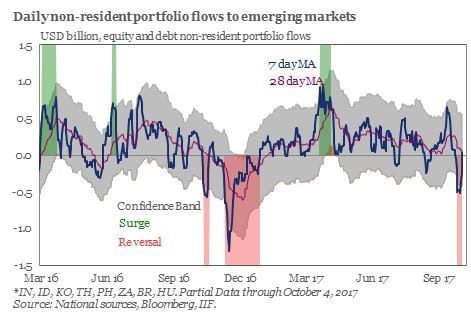Foreign investors have started selling emerging market equities and debt in the past two weeks, according to portfolio flow figures from the Institute of International Finance (IIF) (see graph below).
The trigger was last month’s Fed meeting, during which the US’s central bank announced plans to shrink its balance sheet while chair Janet Yellen hinted another rate hike was likely in December.

Over the whole month of September, flows into emerging market debt were still robust and around the same level as in August after very strong inflows at the start of the month, the IIF estimates.
Trump trade 2.0
Renewed expectations of fiscal stimulus in the US have pushed Treasury yields, the dollar and US bank stocks higher in recent weeks, and hit emerging market assets, in a remarkable mini-repeat of last year’s ‘Trump trade’.
The question is of course whether these recent moves are the start of a new trend, or whether they are just a blip. If the US economy continues to accelerate and expectations for successful tax reform rise, investors will have to brace for further hits to their emerging market debt holdings.
It’s a recurring story of course, the fortunes of emerging market debt are inextricably linked to global macro forces, especially the strength of the dollar and Fed monetary policy.
“Last week’s currency and bond market volatility was triggered by events entirely exogenous to EM itself,” said Jan Dehn, the head of research at Ashmore, who is well known for his positive disposition towards emerging markets. But so was the Taper Tantrum in 2013, which rocked emerging market debt.
Taper Tantrum
Recent events led the IIF to ask the question whether a ‘Taper Tantrum 2.0’ is likely to occur soon. The IIF’s answer is likely to appeal to Dehn and other emerging market investors.
“The underlying driver of the EM sell-off in 2013 was a sharp spike in longer-term Treasury yields. Such a spike looks unlikely to us at the current juncture because first inflation is unlikely to rise meaningfully until Q1 2018; and second, uncertainty around Fed succession is likely to keep hawkish sentiment contained,” the institute said in a note.
Dehn believes the revival of the ‘Trump trade’ is almost inevitably going to be short lived. “A US tax reform, if it materialises, is likely to be modest in size due to constraints on funding following the failure to repeal Obamacare,” he said.
“Besides, the tax cut is more of a fiscal stimulus than a reform per se in that it looks set to add more to the US debt stock than to the trend growth rate. This should ultimately push the long-term equilibrium interest rate (r*) lower and thus support a lower Fed funds rate too,” Dehn added.
Since many investors now already have significant allocations to emerging market debt, it has been the most popular asset class with European investors year-to-date after all, they would probably do wise in resisting Dehn’s unbiased advice to add to their positions on the current weakness.
If we are to see a revival of last year’s Trump trade, including a further rise of the dollar, EM assets may come under sustained pressure, though the protectionist rhetoric that accompanies last year’s EM sell-off is now absent. This means markets are likely to focus on EM fundamentals again in the medium term.







